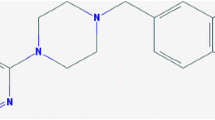Summary.
Ropinirole is effective as mono- and combination therapy in PD. Previous studies have used a maximal dose of 24 mg/day; the present study assesses the effect of higher doses (up to 36 mg/day) on patients with motor fluctuations. Outcome measures were changes in the motor function score of the Unified Parkinson's Disease Rating Scale, the duration of dyskinesias and reductions in levodopa dose.
21/22 patients completed the study. The mean daily ropinirole dose at endpoint was 26.2 mg (SD, 4.43 mg, range 20–36 mg). Improvements in motor function (29%) and the duration of dyskinesias (45%) from baseline to endpoint were significant (p < 0.01 and p < 0.05, respectively). The mean levodopa dose fell by 32% during the study (from 599 mg to 409 mg; p = 0.007). Side effects were mild.
High-dose ropinirole (20–36 mg/day) was well tolerated and conferred significant clinical benefit on patients with motor fluctuations.
Similar content being viewed by others
Author information
Authors and Affiliations
Additional information
Received June 25, 2001; accepted July 9, 2001
Rights and permissions
About this article
Cite this article
Müngersdorf, M., Sommer, U., Sommer, M. et al. High-dose therapy with ropinirole in patients with Parkinson's disease. J Neural Transm 108, 1309–1317 (2001). https://doi.org/10.1007/s007020100007
Issue Date:
DOI: https://doi.org/10.1007/s007020100007




